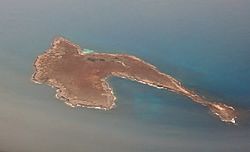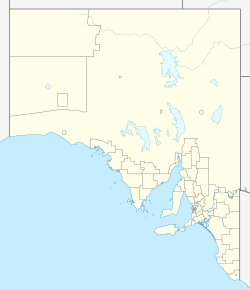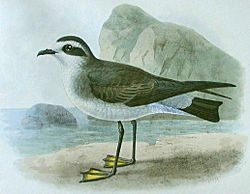Sir Joseph Banks Group facts for kids

Stickney Island
|
|
| Geography | |
|---|---|
| Location | Spencer Gulf |
| Coordinates | 34°35′38″S 136°17′57″E / 34.59389°S 136.29917°E |
| Administration | |
|
Australia
|
|
The Sir Joseph Banks Group is a collection of islands in South Australia. These islands are located in Spencer Gulf, which is a large bay. They are about 20 kilometers (12 miles) away from the eastern coast of the Eyre Peninsula.
This group includes 21 islands. Eighteen of these islands are part of the Sir Joseph Banks Group Conservation Park. This park helps protect the land and its animals. The waters around the islands are also protected in the Sir Joseph Banks Group Marine Park. This marine park helps keep the ocean and its creatures safe. The islands are a very important place where many seabirds come to breed and raise their young.
Contents
Discovering the Sir Joseph Banks Group
The islands are mostly flat, with the highest point on Spilsby Island being about 50 meters (164 feet) high. The islands are made mostly of granite rock, covered by limestone and a hard layer called calcrete or sandy soil.
Reevesby Island and Spilsby Island are the biggest islands in the group. Spilsby Island is owned by a private person. Sheep still graze there, and there are a few holiday cottages for people to stay in.
Which Islands Are in the Group?
The Sir Joseph Banks Group includes these islands:
|
|
|
How to Visit the Islands
You can only reach these islands by boat. The closest town on the mainland is Tumby Bay, which is about 22 kilometers (14 miles) to the north-west. Some islands are not open to visitors. This is because they have very sensitive natural environments that need to be protected.
History of the Islands
The islands were named by an explorer named Matthew Flinders. He named them on February 23, 1802, during his journey on the ship HMS Investigator. The group is named after Sir Joseph Banks, who helped fund Flinders' trip.
Many islands in the group are named after places in Lincolnshire, England. This is where both Flinders and Banks came from. For example, Reevesby Island is thought to be named after Banks' home, Revesby Abbey. Kirkby Island is named after the head of the Royal Society at that time. The closest big town to the islands is Port Lincoln, which also has a name linked to Lincolnshire.
Early Life and Shipwrecks
In the 1800s, some of the islands were used for grazing sheep. On Spilsby Island, a family lived there with about 800 sheep.
The islands have also seen some shipwrecks. In the 19th century, the Governor Gawler ship was wrecked near Hareby Island. In 1891, the ship Theophane also ran aground on one of the islands, but everyone on board was safe.
In September 1903, a fishing boat called Jessica was wrecked. Its crew was found a week later on Stickney Island. They had survived by eating only fish.
In 1920, the boat Ina got stuck at Sibsey Island.
In the early 1900s, a company dug for guano (bird droppings used as fertilizer) on Marum Island.
The boat Eleanor ran aground near Kirkby Island in 1930. It was carrying wheat and was left there.
In 1941, two-way radio communication became possible with Reevesby Island. At this time, a person named Mr. C. Darling owned Reevesby Island. Mrs. R. Adams managed the island.
In 1949, Reevesby Island and other islands in the group were put up for sale. Together, they made up about 2,000 acres of land.
Some islands, like Blyth Island and Sibsey Island, became protected areas in 1967. This was done to help conserve their wildlife.
Wildlife of the Sir Joseph Banks Group
Most islands have low shrubs like nitre bush or African boxthorn. Some areas have taller shrubs like coastal boobialla or coastal daisybush. Sandy areas might have marsh saltbush. The bigger islands still have patches of woodland (areas with trees). Islands where sheep used to graze now have introduced grasses.
Besides native animals like death adders, tiger snakes, and lizards (including goannas), some islands have introduced mammals. These include feral cats, house mice, or chinchilla rabbits. The islands are also home to Australian sea lion breeding colonies. Greater stick-nest rats were brought back to Reevesby Island in 1990-1991. Chinchilla rabbits were brought to Spilsby Island for a business idea that did not work out.
In 1940, someone described the wildlife on the islands. They saw many penguins, quail, fairy-terns, and other seabirds. Cape Barren geese bred there in large numbers. People also found many beautiful shells and different types of seaweed.
In 1941, during a radio demonstration, Mrs. R. Adams on Reevesby Island described hundreds of Cape Barren geese nesting. She also saw a seal swimming and a large penguin burrow under a windmill. She even saw five whales at once from the island!
In 1926, Spilsby Island had thousands of terns and many little penguins. Observers also noted that the southern part of Reevesby Island was a resting place for mutton-birds and rock parrots.
English Island was described in 1926 as having many seals and thousands of breeding cormorants. Each cormorant nest had one to three pale greenish eggs. Australian sea lions were seen at Kirby Island by Matthew Flinders in 1802. They were also seen at English Island in 1935, 1937, and 1940.
In 1937, the McCoy Society explored the Sir Joseph Banks group. They collected specimens, took photos, and made films. They found a large group of terns on Kirkby Island and a "huge colony" of fairy terns on Langton Island. They filmed the Caspian tern colony on Kirkby Island.
Little Penguin Colonies and Life Cycle
Little penguins were first seen on the islands in 1839. An observer noted "plenty" of little penguins, Cape Barren geese, and other birds.
In 1923, a visitor saw hundreds of little penguin nests on every island. The penguins would poke their "meek faces" out from under shelter. Field naturalists also saw little penguins in 1936. However, in 1939, an observer noted that there were not as many penguins in the Banks Group as on other islands.
A survey in 1996 showed that little penguin breeding sites were spread out across the group. It seemed they might be on all the islands.
As of 2011, several penguin groups in the Sir Joseph Banks Group are thought to be getting smaller.
Spilsby Island Penguin Population
The group of little penguins on Spilsby Island is believed to be shrinking as of June 2011. In 1926, there were "numbers of" little penguins on the island. In 1935, a visitor described the penguins on Spilsby Island. They said the penguins had burrows all around the shores. They were not afraid of people and would just watch them.
In 2006, about 2000-3000 little penguins were estimated to live on Spilsby Island. But by 2010, the number was thought to be less than 100 birds. In 2011, the population was described as "few." Landowners and conservation groups say that penguin numbers in Spencer Gulf have dropped a lot since the early 2000s.
Reevesby Island Penguin Population
Little penguins have also been seen on Reevesby Island. In 1907, Douglas Mawson noted many penguins in the hollows of the limestone rocks. In 1941, a little penguin burrow was found under a windmill on Reevesby Island. In 2009, about 1,857 breeding penguins were estimated to be there. This group is also believed to be shrinking.
Sibsey Island Penguin Population
In 1916, three men were stranded on Sibsey Island. They survived for twelve days by eating penguins and penguin eggs. In 2004, only "few" penguins were recorded on Sibsey Island.
Protecting the Islands
Conservation Parks
Eighteen of the islands in the group are part of the Sir Joseph Banks Group Conservation Park. The waters around the islands are also protected by the Sir Joseph Banks Group Marine Park. These parks help keep the islands and their marine life safe.
Important Bird Area
BirdLife International has named the Sir Joseph Banks Group an Important Bird Area (IBA). This is because it is home to a large number of important birds. For example, it supports over 1% of the world's population of white-faced storm petrels (with up to 180,000 breeding pairs). It also has many Cape Barren geese (up to 1200 individuals) and black-faced cormorants (3000 to 5000 breeding pairs). It likely also has many Pacific gulls.
Other seabirds that breed here include little penguins, silver gulls, and greater crested terns. Fairy terns, eastern reef egrets, rock parrots, and muttonbirds have also been seen.
Images for kids







